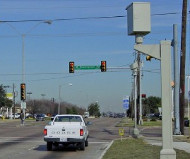10/8/2013
Virginia: Short Yellows, Red Light Cameras Increase AccidentsInjury accidents jump where red light cameras are used in Newport News, Virginia.

Accidents increased at the intersections where red light cameras were installed in Newport News, Virginia. An analysis of six years' worth of collision data by the National Motorists Association (NMA) confirmed that use of photo enforcement failed to deliver on the promise of improved safety in the town of 180,000.
Newport News was one of the first jurisdictions to re-adopt red light cameras after a statewide pause in 2005 when the Virginia Department of Transportation determined accidents increased wherever the devices were used (view report). Heavy lobbying by municipalities and red light camera companies convinced the legislature to give automated ticketing another chance.
Redflex Traffic Systems of Australia has been mailing tickets to vehicle owners at three intersections along Jefferson Avenue in Newport News since May 2010. At Mercury Avenue, there were 41 injury accidents from October 27, 2007 to May 14, 2010, before the cameras were installed. After the devices were active, injury accidents jumped to 64 between May 16, 2010 to September 16, 2013. On an annualized basis, the before period had 15.7 injury crashes per year, which increased 22.8 percent to 19.2 in the after period.
At Denbigh Boulevard, there were 69 injury collisions in the before period, for a rate of 10.7 injury crashes per year. In the after period, there were 40, for a rate of 12.4 injury collisions per year, an increase of 17.4 percent. At Oyster Point Road, there were 38 injury accidents in the before period, or 12.3 per year. In the after period, there were 54 injury accidents, or 15.6 per year, a jump of 50.5 percent.
NMA engineer J.J. Bahen Jr blames the city for exploiting yellow times in the turn lanes that are illegally short. Under state law, signal timing at photo enforced intersections must be established according to the methodology set by the Institute of Transportation Engineers (ITE). Bahen, an ITE member, points out that the city is using a "speed limit minus 5 MPH" methodology for turn lanes that results in overly short yellows. At Oyster Point Road, for example, speed limit is set at 35 MPH, so the yellow is set for traffic approaching the intersection at 30 MPH. In reality, 85 percent of traffic approaches at 45 MPH -- a difference of 15 MPH.
Bahen calculates the yellow time is 1.5 seconds too short, which translates into a large number of citations, with the turning lanes of the three intersections in Newport News generating $2.3 million worth of tickets since 2010. Bahen on Monday asked state officials to clarify their policies to address the shortened yellow problem.
"If local traffic engineers are made aware of state law and ITE guidelines, then hopefully they will increase yellow times to safe and legal levels based on measured approach speeds, taking into account the extra time that drivers need to slow down for the turn," Bahen wrote.


